
239
Cityscape: A Journal of Policy Development and Research • Volume 17, Number 2 • 2015
U.S. Department of Housing and Urban Development • Office of Policy Development and Research
Cityscape
Foreclosed Property Investors
in a Strong Housing Market
City: A Case Study of Boston
Lauren Lambie-Hanson
Federal Reserve Bank of Philadelphia
Christopher E. Herbert
Irene Lew
Rocio Sanchez-Moyano
Joint Center for Housing Studies of Harvard University
Abstract
Falling home sales prices during the recent mortgage crisis were exacerbated by an
increased number of properties coming on the housing market through foreclosures and
short sales. Real estate investors made up a significant share of buyers of foreclosed
residential properties in cities around the country, leading many to ask if, on net, they
provide a stabilizing influence on the market or are detrimental. In this case study, we
explore the scale and nature of investor activity in acquiring foreclosed properties in the
heart of the Boston area. We find that investors purchased about one-half of foreclosed
properties. Despite competition from owner-occupants and mission-driven organizations,
investors were successful in purchasing such a large share of foreclosed properties because
of several characteristics we discuss, particularly their greater access to financing and
ability to pay cash. Although opportunities for favorable returns on investment encourage
investors to purchase homes in the most distressed neighborhoods and to make property
improvements, investors may not pursue the most severely distressed foreclosed
properties or perform the degree of rehabilitation desired by nonprofit organizations.
Introduction
When the housing bust accelerated in 2008, concerns mounted about the effect of rising foreclo-
sure levels, especially in low-income and minority communities where nonprime lending had been
concentrated in the years leading up to the crash. With demand from owner-occupants in these

240
Lambie-Hanson, Herbert, Lew, and Sanchez-Moyano
Refereed Papers
communities plummeting in tandem with rising unemployment and falling home prices, market
analysts expected that foreclosed homes would find few buyers. In fact, although owner-occupant
demand remained weak in areas hard hit by foreclosures, many housing markets experienced a
surge of home purchases by investors absorbing excess supply.
Although the prominence of investors’ presence has received substantial interest, little systematic
assessment has occurred regarding the scale of investor activity, which properties investors acquire,
and what they do with them. This study aims to investigate these topics in one area as a means of
shedding light on how investors are likely to affect local housing markets. This case study focuses
specifically on investor activity in the city of Boston and three other jurisdictions in Suffolk County,
Massachusetts.
We analyze data on foreclosed properties in Suffolk County from 2007 to 2012 to provide a quan-
titative assessment of investor activity. We supplement this analysis with information obtained from
a small sample of interviews with market participants in Boston, including government officials,
staff from nonprofit organizations, real estate brokers, lenders, and investors to paint a portrait of
investors and their activities. Although the number of interviews conducted was limited and only
a small number of investors participated, the results provide some indication of the characteristics,
motivations, and activities of investors to help inform our understanding of how investors have
affected local markets.
Since the housing market downturn began in 2007, investors have played a significant role in ac-
quiring foreclosed properties in Suffolk County, accounting for 44 percent of foreclosed properties
sold at foreclosure auction or out of real estate owned (REO) inventories from 2007 through 2012.
Three-fourths of the investors we identified acquired only three or fewer foreclosed properties in
Suffolk County. Meanwhile, only 7 percent of all investors (totaling 33 different entities) acquired
10 or more foreclosed properties between 2007 and 2012 but accounted for one-half of all investor
foreclosed property acquisitions. Although these large investors acquired properties in neighbor-
hoods throughout Suffolk County, they were more active in neighborhoods with high foreclosure
rates, relatively low median home prices and household incomes, and a large share of households
headed by racial and ethnic minorities. Given the significance of their role in these neighborhoods,
this study largely focuses on the activities of these large investors.
Toward the end of the period we study, mortgage default rates had begun falling and fewer fore-
closed properties came onto the market. Meanwhile, more investors entered the market, driving
up competition for acquiring foreclosed properties. Several investors told us that the prices of
properties sold out of REO and at auction rose substantially over time, even after taking into ac-
count property condition and other characteristics. Despite this increased cost, foreclosed property
investors still bought about one-half of the foreclosed properties sold in Suffolk County in 2012.
Part of the scale of investor activity can be explained by heterogeneous preferences between the
different types of buyers. Investors were active in areas with high foreclosure rates and often had
stronger tastes for distressed housing than most owner-occupants, who are generally assumed to
seek out turnkey properties. Despite this trend, we learned from our interviews that investors faced
competition from nonprofit organizations for distressed properties, and they also competed to buy
move-in-ready properties. We argue that three main characteristics of investors set them apart from

Foreclosed Property Investors in a Strong Housing Market City:
A Case Study of Boston
241Cityscape
other types of buyers: (1) their willingness and ability to purchase at foreclosure auction; (2) their
connections to other real estate professionals; and (3) their greater access to financing, including
their ability to pay cash.
Although much has been made of the significant role that national investment funds and foreign
investors have played in acquiring foreclosed properties in some parts of the country, the large
investors active in Suffolk County for the most part have local roots—at least as of 2012. Some of
these large investors had a long history of owning rental properties in Boston, while others were
new to the market, attracted by the opportunity to acquire properties at lower-than-normal price
points through foreclosure sales. The predominant strategy among large investors in Boston has
been to hold on to these foreclosed properties as rental units. But the spectrum of large investor
strategies has also included those who sold most of their purchases, and others who were roughly
divided in the share held versus the share resold. The lack of a consistent tendency to hold or sell
properties indicates that, in many respects, investors pursued property-specific strategies.
Given that foreclosed properties have often gone through a period of neglect, and so their presence
may exert a blighting influence on the surrounding neighborhood, a key policy concern is whether
investors engage in rehabilitation of properties to any significant degree. Although this study does
not attempt to systematically measure the degree of rehabilitation investors undertake, we argue
that Boston’s relatively high housing values and significant rental demand provide incentives for
investors to maintain these properties in at least decent condition.
That said, we learned from our interviews that investors did not make property improvements to
the extent that nonprofit organizations felt was desirable. This difference likely reflects the fact that
nonprofit organizations were pursuing broader goals of neighborhood revitalization with the sup-
port of government subsidies, while investors’ decisions about the degree of investment to make
were driven purely by expectations of higher rents or resale values.
The article proceeds as follows. In the next section, we briefly review the existing literature on the
role of private investors in acquiring foreclosed properties in cities around the United States. Then
we provide an overview of housing market conditions and demographic traits of Suffolk County,
the focus of this study. In the third section we describe the methods used in our analysis and docu-
ment the scale of investor activity and the characteristics of the neighborhoods in which investors
are most active. In the fourth section we describe the ways in which investors successfully compete
to purchase foreclosed properties. Then we discuss their decisions to resell or hold properties and
whether to make property improvements. We finally summarize our findings and discuss their
likely applicability to other cities.
Previous Research About Investors
To address the policymakers’ and academic communities’ growing interest in foreclosed property
investors, this study and three others were commissioned to explore investor behavior in four
cities: (1) Boston, Massachusetts; (2) Atlanta, Georgia; (3) Cleveland, Ohio; and (4) Las Vegas,
Nevada. Immergluck and Law (2014) compared and contrasted the behavior of foreclosed single-
family home investors in Atlanta and the surrounding suburbs in Fulton County, Georgia, tracking

242
Lambie-Hanson, Herbert, Lew, and Sanchez-Moyano
Refereed Papers
their behavior from 2002 to 2011. The investors they interviewed had moderate to high levels of
spending on renovations, particularly relative to the low property acquisition costs in the area, and
respondents indicated that they were either content with or eager for even stricter code enforcement.
Ford et al. (2013) found more evidence of problematic investor behavior in Cleveland. Although
institutional investors tended to avoid investing in central city neighborhoods, out-of-state
investors (primarily noninstitutional) who purchased in these neighborhoods were likely to
underestimate the costs required to stabilize and renovate the deteriorated properties. Mallach
(2014) studied single-family home and condominium foreclosures in four ZIP Codes in Las Vegas
and argued that foreclosed property investors provided a stabilizing influence in those neighbor-
hoods, but that, over time, investors increasingly crowded out prospective owner-occupants. After
conducting windshield surveys of a sample of properties in his study area, Mallach concluded
that investor-owned properties had poorer exterior conditions but were not so inadequate as to be
considered blights in the immediate neighborhoods. Similar to Boston, relatively few investors in
Las Vegas purchased many properties.
1
Using a similar approach, Ellen, Madar, and Weselcouch (2014) examined data on sales of foreclosed
properties in Atlanta, Miami, and New York City, and found that investors played a large role in
purchasing REO properties in these cities. In Atlanta, investors were most active in moderately hit
neighborhoods, although, in Miami and New York, they were more commonly active in neighbor-
hoods with the most distressed properties. In all three cities, small-scale investors made up more
than two-thirds of the investor REO purchases, and few purchases by investors resulted in “flips.”
Treuhaft, Rose, and Black (2011) reviewed research from the 1990s and argued that large, nonlocal
investors, particularly those who purchase properties in bulk, were less desirable than homeowners and
small, local investors who are committed to property rehabilitation. Fisher and Lambie-Hanson (2012)
analyzed data on the purchases and investment behaviors of investor-owners and owner-occupants
in Chelsea, one of the cities in Suffolk County, Massachusetts. Basing their analysis on building permits
data, they found that local investors purchasing one- to three-family homes before the foreclosure
crisis planned to make greater investments than owner-occupants and nonlocal investors. Although
local press reports (for example, McKim, 2008) suggested that several large local investors in our sample
were slow to make improvements to the foreclosed properties they purchased, evidence from our
interviews indicates that numerous local REO investors spent a substantial amount on rehabilita-
tion. We discuss this issue in greater detail in the section Postpurchase Property Management.
Treuhaft, Rose, and Black (2011) stressed that, because investors disproportionately purchased dam-
aged REO properties, the business models they use are crucial to determining their effect on neighbor-
hoods. Numerous scholars have turned to Mallach’s (2010a) typology of foreclosed property investors
as rehabbers, flippers, milkers, and holders. We discuss these groups in the section Postpurchase
Property Management. King (2012) found evidence of all four investor types in Oakland, California,
between 2007 and 2011. During that time, investors made up nearly one-half of all foreclosed property
purchases, which is similar to the share in Suffolk County, Massachusetts. King expressed some surprise
that investors did not capture an even greater share, considering “the competitive advantage that cash
investors wield at multiple stages in the post-foreclosure home buying landscape” (King, 2012: 5).
1
For a comprehensive summary and comparison of the four case studies, see Herbert, Lew, and Sanchez-Moyano (2013).

Foreclosed Property Investors in a Strong Housing Market City:
A Case Study of Boston
243Cityscape
Although maintaining a strategy to hold may be potentially desirable from a neighborhood perspective,
it may be prohibitively expensive from the perspective of profit-motivated investors—particularly
those supplying housing at affordable rents. Typical rehabilitation costs for foreclosed properties
may be infeasible for many owners, given that profit margins for small rental properties are often
slim. Mallach (2007) wrote that, in 1995, less than 40 percent of the owners of one- to four-family
rental properties reported that they had made a profit on their property during the preceding year.
An analysis of data from the 2001 Residential Finance Survey and the 2007 American Housing Sur-
vey by Garboden and Newman (2012) tells a similar story. Their study found that only 5 percent of
small (one- to four-unit) affordable rental properties, which are typically owned by individuals or
couples, were in economically stable condition. More than one-half (65 percent) of the units could
have been salvaged but were at risk of losing affordability, and 30 percent could not be salvaged.
Trends and Conditions in the Boston Housing Market
The specific focus of this study is on foreclosed properties in Suffolk County, the core county of
the Boston metropolitan area, consisting of the cities of Boston, Chelsea, Revere, and Winthrop.
Although not as dramatic as in some U.S. housing markets, Suffolk County experienced a sub-
stantial housing boom and bust during the 2000s. From the start of the decade through the peak
in November 2005, home sales prices in Suffolk County increased 86 percent. National prices
continued to climb into 2006, however. After the peak, prices in Suffolk County began a steady
decline, bottoming out in March 2009 at about 29 percent below peak values. Nationwide, during
the same period, prices declined 28 percent. In exhibit 1 we display Suffolk County’s house price
index, along with the national index and the indices for Cuyahoga County (Cleveland), Clark
County (Las Vegas), and Queens County (in New York City). As discussed in the previous section,
these three places have also been the subject of foreclosed property investor case studies.
2
Clark
County experienced both a dramatic increase and subsequent decline in house prices in the 2000s.
In Queens, prices also rose rapidly and then fell, although the decline was far less severe than that
of Las Vegas. Cuyahoga County experienced very little growth in prices from 2000 to 2005, and
while prices did decline beginning in 2006, the reduction was also comparatively small.
Coinciding with falling house prices, Suffolk County saw a large increase in the number of
foreclosed properties.
3
As shown in exhibit 2, during May 2010, the height of its foreclosure crisis,
Suffolk County experienced 12.7 foreclosures per 10,000 homes. From 2009 through mid-2012,
Suffolk County’s rate of foreclosure completions was very similar to the national rate and to the rate
for Cuyahoga County. Cleveland’s foreclosure crisis began in 2005, however, well before most of
the rest of the country. As of the end of 2012, it had also shown less improvement than other areas.
But all the places profiled in exhibit 2 had foreclosure rates that paled in comparison with that
of Las Vegas, where in May 2011, nearly 59 foreclosures occurred per 10,000 homes. Since then,
however, Las Vegas has seen rapid improvement. In December 2012, only 12 foreclosures were
completed per 10,000 homes.
2
Among all the places discussed in the section Previous Research About Investors, these areas were chosen because of the
availability of Zillow foreclosure data, displayed in exhibit 2.
3
Here we define foreclosures as foreclosures completed—that is, foreclosure deeds terminating the mortgage and the
owner’s rights to the property.
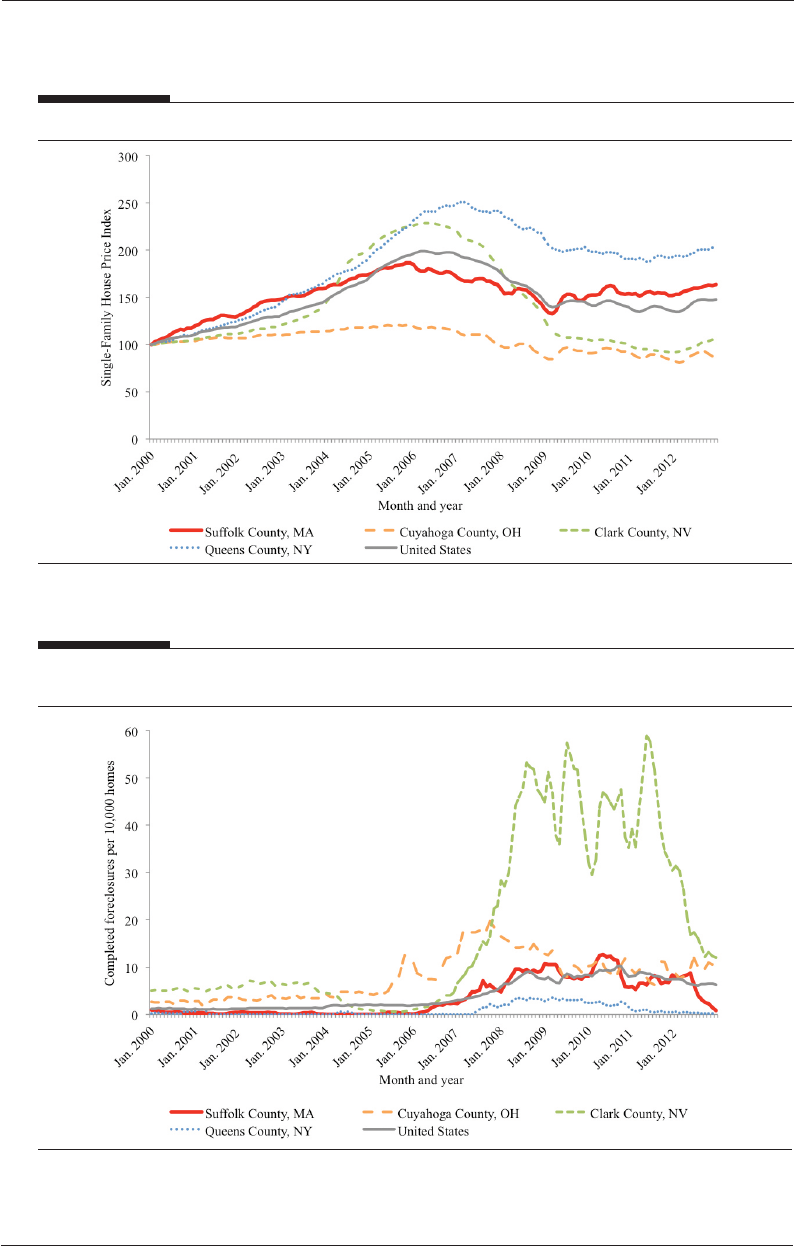
244
Lambie-Hanson, Herbert, Lew, and Sanchez-Moyano
Refereed Papers
Exhibit 1
House Sales Price Trends in Suffolk County, Massachusetts, and Other Areas, 2000–2012
Source: Authors’ tabulations of data from CoreLogic, Inc. House Price Index
Exhibit 2
Monthly Number of Foreclosures Completed, per 10,000 Homes, in Suffolk County,
Massachusetts, and Other Areas, 2000–2012
Note: Foreclosure completions are counts of foreclosure deeds, regardless of whether properties are sold at foreclosure
auction to a third-party buyer or become real estate owned (REO).
Source: Authors’ tabulations of foreclosure data from Zillow
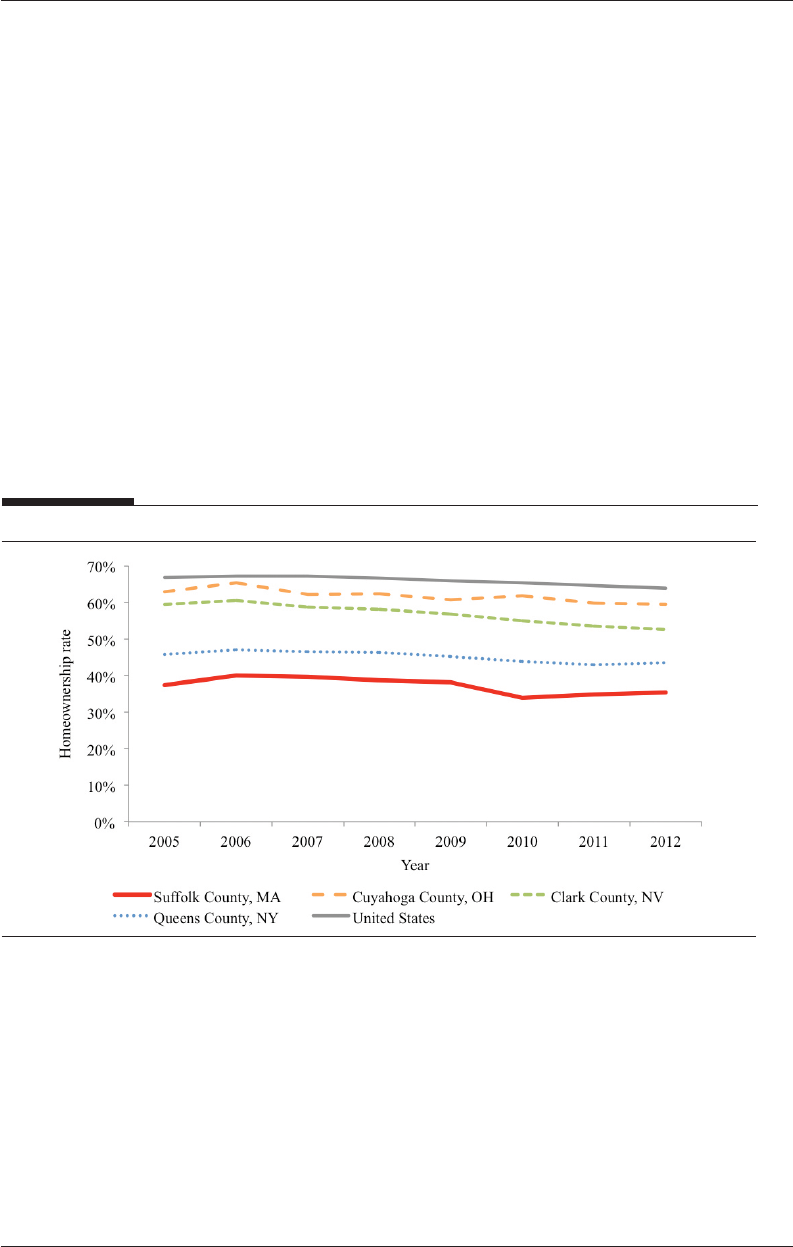
Foreclosed Property Investors in a Strong Housing Market City:
A Case Study of Boston
245Cityscape
As the urban core of the Boston area, Suffolk County is marked by higher density, older housing
stock. According to 2012 American Community Survey data, 55 percent of units in the county
were built before 1940, while 18 percent of units were built after 1980. Less than 20 percent of the
housing stock is single-family homes. Multifamily structures, split evenly between small multifam-
ily buildings with two to four units and larger buildings, made up most of the stock. In terms of
population demographics, 48 percent of the residents were nonminority, 20 percent were African
American, and another 21 percent were Hispanic or Latino. The median household income in Suf-
folk County was about $51,000, and the poverty rate among individuals was 21 percent.
As shown in exhibit 3, following the national trend, homeownership rates in Suffolk County fell
from 40 percent in 2006 and 2007 to 35 percent in 2012. Even at the peak of homeownership,
renters accounted for a clear majority of households. With such a low homeownership rate and a
significant stock of small multifamily buildings, investors have long been active in Boston, but as
evidenced by the falling homeownership rate in recent years, they have increased their presence in
the market.
Exhibit 3
Homeownership Rates for Suffolk County, Massachusetts, and Other Areas, 2005–2012
Source: Authors’ tabulations of data from the U.S. Census Bureau’s 2005–2012 American Community Survey 1-year data

246
Lambie-Hanson, Herbert, Lew, and Sanchez-Moyano
Refereed Papers
Data and Methods
To assess the role that investors have played in acquiring foreclosed properties, we analyze data on
individual transactions involving foreclosure deeds in Suffolk County from a private vendor, the
Warren Group, for the period from 2007 through 2012. The transactions we study include both
properties sold to third parties at the foreclosure auction and those sold by lenders subsequent to
taking title at auction. In this way, we focus on one slice of investor activity, ignoring short sales
and other ways in which investors may purchase properties that were once owned by borrowers in
mortgage distress.
4
We identified investors in two ways: (1) any purchaser whose name was a corporate or legal entity,
rather than an individual’s name, was considered an investor; and (2) any named individual was
considered an investor if he or she purchased more than one foreclosed property in Suffolk County
over the period of study. Linking transactions to the same investor was made difficult by the fact
that investors may use different legal entities to acquire properties, and misspellings may exist
in the database. To account for these discrepancies, we reviewed the buyers’ names in detail and
collected additional information on their addresses and the names of their corporate officers.
5
We
acknowledge that this method understates the level of investor activity to the extent that individu-
als acquire only a single foreclosed property in their own name over the period studied.
This article focuses on 4,700 single-family, two-family, three-family, and condominium properties
that were sold out of foreclosure between 2007 and 2012.
6
Of these foreclosures, 3,830 (81 percent)
were purchased out of REO, while the remaining 870 were purchased directly by third-party buyers
at foreclosure auction and thus never became REO. We identified 320 unique individuals or groups
of investors who purchased two or more foreclosed properties in Suffolk County (exhibit 4).
7
These
buyers purchased a total of 1,947 properties, 41 percent of the sample. Another group of buyers
each purchased only one foreclosed property during our study period but appeared to be corporate
entities, based on a keyword search of the buyer names, including the terms “LLC” (limited liability
company), “Corp.” (corporation), “Inc.” (incorporated), and so on. These owners together bought
4
We unfortunately lack information on short sales in our dataset. Unlike the deeds for foreclosed properties, the deeds for
short sale transactions appear identical to those of arm’s-length transactions (that is, traditional sales in which the price
reflects the market value). As a result, it is not possible to distinguish short sales from arm’s-length sales in real estate
transactions data based on records from local registries of deeds. We also exclude properties surrendered via deeds-in-lieu
of foreclosure, but only a handful of these transactions took place in Suffolk County between 2007 and 2012.
5
Specifically, we used the buyers’ addresses (and in the case of LLCs, the officers), from the Massachusetts Corporate
Database and the Suffolk Registry of Deeds to distinguish between—and link—buyers. On the rare occasions that address
information was missing or ambiguous, we were able to determine if John Doe A and John Doe B were the same person
by looking up their mailing address information in the City of Boston Assessor’s database and comparing their signatures
on documents in the Registry. The owner’s address data unfortunately were not available for the entire county during our
study period and were of insufficient quality across jurisdictions to use mailing addresses as a primary means of identifying
investors.
6
The sample includes foreclosures completed (that is, foreclosure auctions taking place) between 2007 and 2012. This
analysis focuses only on foreclosed properties sold to third-party buyers; in other words, properties still in REO as of the
beginning of 2013 are excluded. It also excludes properties with four or more units that were not condominiums.
7
This total excludes government and nonprofit organizations, which purchased 143 of the properties in the sample (about
3 percent).

Foreclosed Property Investors in a Strong Housing Market City:
A Case Study of Boston
247Cityscape
Exhibit 4
Investors by Number of Foreclosed Properties Purchased
Foreclosed
Properties
Purchased (n)
Investors (n)
Share of
Investors (%)
Total Foreclosed
Properties
Purchased (n)
Share of
Investor-Owned
Properties (%)
1 117 27 117 6
2 147 34 294 14
3 60 14 180 9
4 33 8 132 6
5 to 9 47 11 295 14
10 to 19 15 3 214 10
20 to 49 14 3 418 20
50 or more 4 1 414 20
Total 437 100 2,064 100
Note: Percentages may not add to 100 because of rounding.
Source: Authors’ calculations of data from the Warren Group
117 properties.
8
In total, from 2007 to 2012, 437 unique investors purchased 2,064 properties in
the sample (44 percent). Overall, 60 percent of these investors purchased one or two properties.
Only 1 percent, four investors, purchased 50 or more REOs or foreclosure auction properties.
These purchases, however, amounted to 20 percent of all investor-owned properties. Including
these four largest investors, 33 investors purchased 10 or more properties, totaling one-half of the
investor-purchased properties and 22 percent of all properties sold out of foreclosure in Suffolk
County during this time. We classify those who purchased 10 or more properties as “large investors.”
We have a good deal of information in the Warren Group data about the frequency, timing, and
price points of these purchases. To gain additional information, we interviewed a total of 16
housing market participants in late 2012 and early 2013. Participants were not randomly sampled.
We contacted city agencies and community development corporations (CDCs) active in neighbor-
hoods with high foreclosure rates to request their participation and their suggestions for potential
interview subjects. To a lesser extent, we also used public records information to identify and
reach out to investors. Recruiting investors to participate proved difficult. We ultimately conducted
informal interviews with two small investors, four large investors, three staff members from a city
agency, five staff members employed by local CDCs and other nonprofit organizations, a lender,
and a real estate broker. Although this sample is neither large nor representative, the diversity of
the participants helped us gather information from a variety of perspectives.
8
Individual (noncorporate) buyers who purchased only one foreclosed property and resold it within 1 year accounted for
an additional 157 foreclosed property acquisitions during the study period. Even after a manual inspection of a sample
of these records, it is unclear if the buyers are investors or owner-occupants. In the interest of conservatively measuring
investor activity, we do not treat these buyers as investors.

248
Lambie-Hanson, Herbert, Lew, and Sanchez-Moyano
Refereed Papers
Investors and Their Strategies
Except for the initial years of the housing crisis, 2007 and 2008, investors bought about one-half of the
foreclosed properties sold each year at auction or out of REO (see exhibit 5). The scale of large investor
activity followed a similar pattern. While large investors purchased 9 percent of the foreclosures in
2007 and 14 percent in 2008, they captured more than one-fourth of 2009 through 2012 sales.
Most foreclosed property investors in Boston are locally based. Focusing on only our sample of
33 large investors, more than one-half (18) were based in Suffolk County, 39 percent (13) were
based elsewhere in Massachusetts (typically in the greater Boston area), and 6 percent (2) were
located out of state.
9
Several of the investors had a long history of investing in these neighbor-
hoods, in some cases as long as 20 to 30 years, while others were new to property investment. No
internationally based large investors were in our sample. The smaller investors we studied were
also mostly based in Boston and adjacent communities. The near absence of nonlocal investors in
Boston sets it apart from other cities, such as Atlanta and Cleveland, which have been targeted by
institutional and foreign investors. We suspect that the higher sales prices of foreclosed properties
relative to rents in Boston discouraged outside investment.
Exhibit 5
Share of All Foreclosed Properties Purchased, by Investor Type and Year
Purchase Year Total Purchases (n)
Bought by Investors
(%)
Bought by Large
Investors (%)
2007 290 20 9
2008 1,118 34 14
2009 1,184 50 28
2010 915 50 25
2011 624 48 26
2012 569 49 26
Total 4,700 44 22
Notes: Large investors purchased 10 or more foreclosed properties from 2007 to 2012. “All Foreclosed Properties” includes
properties sold out of real estate owned (REO) status or at foreclosure auction.
Source: Authors’ calculations of data from the Warren Group
Where and What Investors Purchase
Investors bought a greater percentage of foreclosed homes in the neighborhoods (defined here
as census tracts) where the foreclosure rates were highest. These neighborhoods also happen to
have the highest concentrations of minority households. Exhibit 6 shows that neighborhoods
where more than 80 percent of households were minorities experienced foreclosures at a rate of
9
The geographic location of the investors is the assumed place of business, based on records in the Massachusetts Secretary
of State’s online corporate database. When addresses appeared to be those of local agents rather than investors themselves,
we looked for further information, such as addresses in the purchase deeds filed in the local Registry of Deeds. In some
cases, the address appeared to be the investor’s place of residence. In the few instances in which multiple addresses for a
given individual were identified, the most common location was used.

Foreclosed Property Investors in a Strong Housing Market City:
A Case Study of Boston
249Cityscape
Exhibit 6
Neighborhood Characteristics, by Minority Household Share and Household Income Level
Tract Characteristics
Minority Share of Households
> 80% 60–80% 40–60% 20–40% < 20% All
Foreclosure rate (%) 8.7 5.5 3.5 3.4 1.8 4.5
Investors’ share of
foreclosed properties (%)
58 44 36 32 35 46
Large investors’ share of
investor purchases (%)
58 49 48 56 23 52
Homeownership rate (%) 34 38 42 43 54 42
Average house value/unit ($) 154,625 202,155 264,187 239,268 343,442 223,011
Average share of single-
family homes (%)
24 27 31 26 29 27
Average share of two- to
three-family units (%)
56 46 33 33 24 42
Average share of
condominiums (%)
20 27 37 41 46 31
Tract Characteristics
Household Income Relative to Suffolk County
< 80% 80–100% 100–120% > 120% All
Foreclosure rate (%) 7.3 4.9 4.0 1.6 4.5
Investors’ share of
foreclosed properties (%)
52 44 40 37 46
Large investors’ share of
investor purchases (%)
54 53 54 35 52
Homeownership rate (%) 30 39 51 56 42
Average house value/unit ($) 159,631 233,287 218,375 355,404 223,011
Average share of single-
family homes (%)
24 27 31 26 29
Average share of two- to
three-family units (%)
56 46 33 33 24
Average share of
condominiums (%)
20 27 37 41 46
Notes: The reported foreclosure rate includes only properties transferred to a third party and does not include those still held
as real estate owned (REO). “Household Income Relative to Suffolk County” reflects the tract median household income as
a percentage of the Suffolk County median household income. “Large investors’ share of investor purchases” indicates the
percentage of all investor-purchased foreclosed properties that were bought by 1 of the 33 investors who purchased 10 or more
properties in the dataset. Group averages and rates are weighted by number of transactions, properties, or units, as appropriate.
Sources: Authors’ tabulations of data from U.S. Census Bureau’s 2005–2009 American Community Survey 5-year estimates;
authors’ tabulations of data from the Warren Group
8.7 percent, nearly double the countywide rate of 4.5 percent and almost five times the rate in
neighborhoods with a minority household share of less than 20 percent. Tract-level data on the share
of minority households are displayed side-by-side with foreclosure rates in exhibit 7. Chelsea and the
Boston neighborhoods of Roxbury, Dorchester, Mattapan, and East Boston all had high concentra-
tions of minority households, and they also included most of the county’s highest foreclosure tracts.
These neighborhoods overlap heavily with Suffolk County’s lowest income areas. Neighborhoods
with median incomes less than 80 percent of the county median had a foreclosure rate of 7.3 percent,
compared with 1.6 percent for neighborhoods with incomes above 120 percent of the county median.
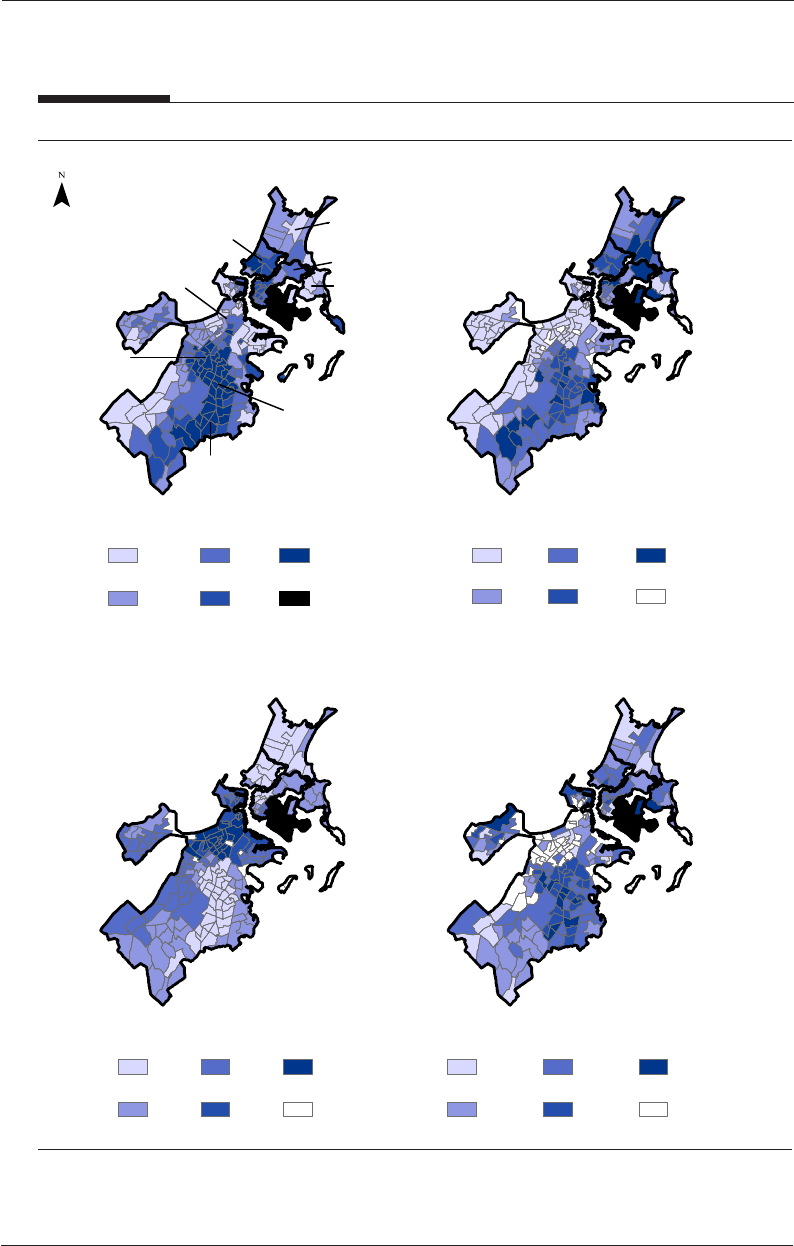
250
Lambie-Hanson, Herbert, Lew, and Sanchez-Moyano
Refereed Papers
Exhibit 7
Suffolk County, Massachusetts, Neighborhood Characteristics and Investor Prevalence
Share of households non-White
and/or Latino, 2005–2009
Foreclosure RatePercent Minority
Median Price per Square Foot
Investor Share of
Foreclosed Property Purchases
2.0% or less
2.1–5.0%
5.1–10.0%
10.1–15.0%
Over 15.0%
Few properties
67–144
145–250
251–400
401–500
501–787
Few sales
20.0% or less
20.1–35.0%
35.1–50.0%
50.1–65.0%
Over 65.0%
< 5 foreclosures
Foreclosure rate for one- to three-family
and condominium properties, 2007–2012
Median price per square foot
arm’s-length sales, 2007–2012
Percentage of foreclosed properties
sold to investors, 2007–2012
20.0% or less
20.1–40.0%
40.1–60.0%
60.1–80.0%
Over 80.0%
Logan Airport
Chelsea
Revere
East Boston
Winthrop
Boston
Roxbury
Dorchester
Mattapan
Note: Cities are outlined and labeled in bold.
Sources: Authors’ tabulations of data from the U.S. Census Bureau’s 2005–2009 American Community Survey 5-year
estimates; authors’ tabulations of data from the Warren Group
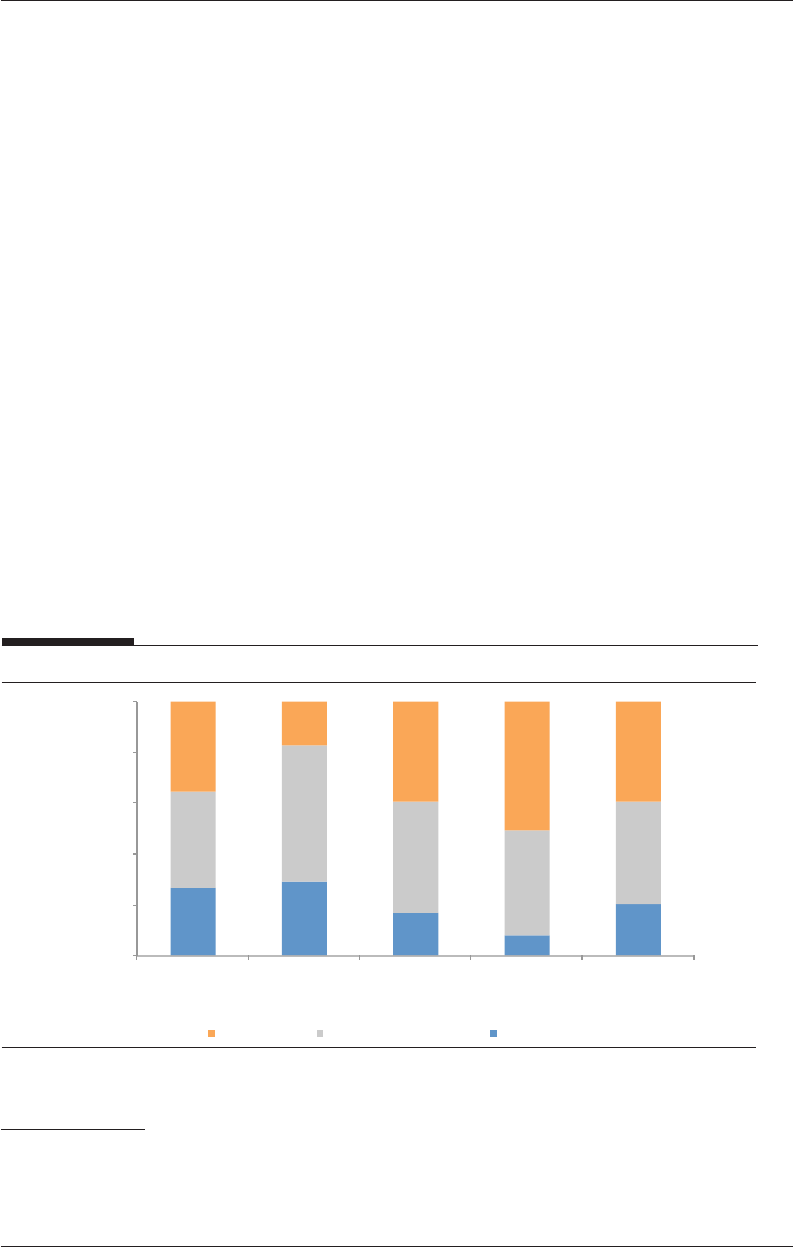
Foreclosed Property Investors in a Strong Housing Market City:
A Case Study of Boston
251Cityscape
Investors purchased 58 percent of foreclosed properties in neighborhoods that had 80 percent or
more minority households and 44 percent in areas with 60- to 80-percent minority households,
compared with about a third in other neighborhoods. Likewise, investors purchased a little more
than one-half of foreclosed properties in the lowest income neighborhoods but only 37 percent in
the highest income areas.
10
Other housing market factors exist in these neighborhoods that may have
influenced investor activity. Homeownership rates are low in Suffolk County’s low-income and majority-
minority neighborhoods. The high share of small multifamily properties, compared with other
structure types, provides an attractive rental market in these neighborhoods and may hinder purchases
by owner-occupants. Average house values per unit (displayed in exhibit 6) and median sales prices
per square foot (displayed in exhibit 7) were also much lower in low-income and high-minority tracts.
Compared with investor activity overall, large investors were notably less active in the highest
income and lowest minority tracts, where property values were highest. The investors we inter-
viewed primarily focused on the lower income neighborhoods of Dorchester, Roxbury, Chelsea,
and Mattapan. One of the investors reported that he perceived himself as a “value investor” who
was not interested in acquiring properties in higher income neighborhoods, arguing that the rents
in these areas could not offset the higher purchase prices.
As displayed in exhibit 8, large investors targeted multifamily (two- and three-family) properties
and condominiums. Only 8 percent of purchases by large investors were single-family properties,
in contrast with 17 percent of purchases by small investors and 27 percent of the foreclosed
Exhibit 8
Types of Properties Purchased by Purchaser Type
27
29
17
8
20
38
54
44
41
40
35
17
39
51
39
0
20
40
60
80
100
Homeowner Mission-driven
organization
Small investor Large investor All buyers
Percent of foreclosed properties purchased
Purchaser type
Condominium Small multifamily Single-family
Notes: Mission-driven organizations include nonprofit organization and government buyers. Large investors purchased 10 or
more foreclosed properties in the sample. Small investors purchased 1 to 9 foreclosed properties.
Source: Authors’ calculations of data from the Warren Group
10
Note that the total rate of investor activity reported in exhibit 6 (46 percent of foreclosed properties) does not precisely
match the countywide total reported in exhibit 5 (44 percent). This discrepancy is because a small number of tracts are
omitted from the analysis in exhibit 6 because they lacked a sufficient number of transactions to have reliable data on each
field included in the exhibit.

252
Lambie-Hanson, Herbert, Lew, and Sanchez-Moyano
Refereed Papers
properties acquired by owner-occupants. Large investors were particularly likely to purchase
condominiums, which were 51 percent of their purchases. Condominiums made up 39 percent
of small investors’ purchases and 35 percent of the properties bought by owner-occupants. The
remaining 41 percent of purchases by large investors were two- and three-family properties. The
concentration of investment activity in small multifamily and condominium properties can be
explained by the facts that these properties are often better suited for rentals than are single-family
properties and are located in neighborhoods where sales prices have been lower.
The condominium properties in these neighborhoods tend to be part of small multifamily build-
ings, which were formerly wholly owned parcels. Conversions of multifamily properties to condo-
miniums were common in the 1980s and 1990s, with most of the properties having only two or
three units (City of Boston, 2000). Small multifamily property conversions to condominiums were
also in vogue into the mid 2000s, as housing prices peaked (City of Boston, 2005). Conversion
date information is not readily available, which makes it difficult to systematically analyze how
recently foreclosed properties had been converted. We manually traced a number of condominium
foreclosures in our sample, however, using records on file in the Suffolk Registry of Deeds. We found
that many foreclosed condominium properties had been converted from small multifamily rental
properties in the early 2000s. Assuming that the properties were brought up to code and perhaps
renovated at the time of conversion, it is likely that many of the foreclosed condominiums purchased
by investors may have required few or no improvements to make them habitable. Further, unless an
investor acquired all the condominium units in a building, he would not bear the full cost of any ex-
terior improvements. Thus, we would expect condominium units in particular to be attractive to both
prospective owner-occupants and investors. Small multifamily dwellings were the primary focus of
nonprofit organizations, making up more than one-half of their property acquisitions. These proper-
ties offer more opportunities for housing development as they have more units and, according to our
interviews, often required significant improvements to make them marketable for resale or rentals.
Methods of Identifying and Acquiring Foreclosed Properties
During the period we study, the volume of completed foreclosures rose dramatically and then
began to gradually decline as mortgage default rates fell. The investors we interviewed in 2012 and
2013 observed that fewer properties had been coming on the market. One investor attributed this
decline to legislation that took effect in Massachusetts in the preceding few years, which created
a backlog in the number of properties that went through the foreclosure process and affected the
number of foreclosed properties for sale in Suffolk County.
11
At the same time, more investors
entered the market, increasing competition for properties. With fewer foreclosed properties on the
market and increased competition to purchase them, “the foreclosure market is on life support,”
one investor noted. The result, investors told us, was that the price of distressed properties sold
11
Massachusetts extended the foreclosure process in 2008 and 2010 by instituting “right-to-cure” laws that stalled the
foreclosure process by 90 and 150 days, respectively, to provide a “cooling off” period for borrowers and lenders to work
together to achieve mortgage modifications and avoid foreclosure (Gerardi, Lambie-Hanson, and Willen, 2013). Landmark
court cases also influenced the number and timing of foreclosures. U.S. Bank v. Ibañez ruled that lenders must prove that
they hold the mortgages in question before they are able to foreclose. In this sense, the title must be clear at the time
of auction or the sale would be voided. Eaton v. Federal National Mortgage Association ruled that lenders must provide
documentation that they hold both the promissory note and mortgage. These decisions forced some foreclosures to be
repeated and others to be stalled while lenders and servicers worked through the new rules.

Foreclosed Property Investors in a Strong Housing Market City:
A Case Study of Boston
253Cityscape
out of REO in Boston increased significantly during the later years of the foreclosure crisis, making
them less attractive to investors as potential profit margins shrunk. For example, one investor
noted that early in the crisis he bought multifamily properties for $275,000, but by 2012 the same
kind of properties had sales prices that were $100,000 higher.
In our dataset, we see clear evidence of falling sales volumes over time, and some evidence indicates
that REO sales prices increased over time. The data tell an incomplete story, because we cannot
account for property conditions or features beyond neighborhood location and basic property
attributes reported in assessors’ data, namely property size, age, and numbers of bedrooms and
bathrooms.
12
In exhibit 9 we display the simple median REO sales prices and volumes by year and
property type for all of Suffolk County and the two ZIP Codes that experienced the greatest number
of foreclosures. County median sales prices for all property types were at their lowest points in
2009—the year that the overall house price index bottomed out in Suffolk County (see exhibit 1).
The median price for condominiums sold out of REO, for example, was $79,900 that year. In
2012, REO condominiums sold at a median price of $149,900, an increase of nearly 88 percent.
The volume of sales fell by more than one-half between 2009 and 2012.
More appropriate is to examine changes in sales prices within particular neighborhoods. Here we
use ZIP Codes a proxy for neighborhoods. In ZIP Code 02124, which falls in part of the Dorchester
neighborhood of Boston, 519 one- to three-family properties and condominiums were purchased
out of REO between 2007 and 2012. Most of these purchases (60 percent) occurred in 2008 and
2009 alone. For all property types except single-family homes—which as we reported, investors
target less frequently—median prices were at or near their lowest points in 2009. REO prices held
mostly stable in the following years, although medians were higher for small multifamily properties
and condominiums sold in 2012, increasing 10 to 60 percent.
The second greatest number of foreclosed properties bought out of REO (497) was in ZIP Code
02151, covering the city of Revere. In 02151, as in 02124, the median sales price of single-family
REO properties was somewhat lower in 2012 than in 2009, although the median price of REO
condominiums increased 37 percent. Two-family REO property median prices held steady, and
there were relatively few three-family REO properties sold.
Despite the fact that median sales prices were somewhat higher in 2012, particularly for the
property types investors most heavily targeted, investors still purchased about one-half of the
foreclosed properties sold in 2012. The 33 largest investors alone purchased 26 percent of fore-
closed properties. Given the competition for foreclosed properties from nonprofit organizations,
government, and prospective owner-occupants, how did investors capture such a large share?
From our interviews and data analysis, we learned of three main advantages that many investors
possess—particularly large investors. First, investors are often able to purchase properties at fore-
closure auction, before they ever become REO. In contrast, owner-occupants and mission-driven
organizations rarely buy properties at auction. Second, investors appeared well connected and
savvy, having timely knowledge of properties coming on the market as REO. Third, and perhaps
most important, investors have had better access to financing for purchase and rehabilitation.
12
We used a hedonic model to estimate the purchase price for REO properties, controlling for these traits, but the results
simply reaffirmed the patterns in median sales prices discussed in this section. Results are available upon request.

254
Lambie-Hanson, Herbert, Lew, and Sanchez-Moyano
Refereed Papers
Exhibit 9
REO Median Sales Prices and Transaction Volumes, by Year
Year of Sale
Median Sales Price ($) Sales Volume (n)
Single-
Family
Two-
Family
Three-
Family
Condo-
minium
Single-
Family
Two-
Family
Three-
Family
Condo-
minium
Suffolk County, Massachusetts
2007 270,511 308,475 362,625 210,750 82 48 30 62
2008 212,160 235,000 240,000 101,000 200 246 228 353
2009 165,000 195,000 200,000 79,900 179 232 178 403
2010 181,750 200,000 210,000 95,000 142 128 111 285
2011 184,900 203,000 225,000 111,300 101 82 64 227
2012 176,000 208,125 263,000 149,900 105 88 63 179
Percent change
2009–2012
7% 7% 32% 88% – 41% – 62% – 65% – 56%
Dorchester: ZIP Code 02124
2007 310,000 350,000 378,500 122,500 13 9 6 4
2008 207,500 250,000 247,000 65,000 22 29 45 62
2009 150,000 175,900 214,000 70,000 21 31 33 69
2010 153,000 197,625 210,000 75,000 13 11 19 37
2011 150,000 177,500 221,000 86,000 7 12 11 19
2012 145,100 281,000 235,300 105,000 8 8 14 16
Percent change
2009–2012
– 3% 60% 10% 50% – 62% – 74% – 58% – 77%
Revere: ZIP Code 02151
2007 251,250 295,950 527,000 208,000 22 14 1 6
2008 215,000 234,250 225,000 200,000 45 44 21 31
2009 177,500 215,000 200,000 116,000 38 43 7 23
2010 145,450 215,000 231,450 140,000 28 22 6 17
2011 166,000 221,556 240,500 105,500 23 19 2 16
2012 153,000 215,000 251,600 159,000 24 17 4 24
Percent change
2009–2012
– 14% 0% 26% 37% – 37% – 60% – 43% 4%
REO = real estate owned.
Source: Authors’ calculations of data from the Warren Group
Purchases at Foreclosure Auction
Properties sold at foreclosure auction are either bought by third-party buyers (investors or
intended owner-occupants) or become bank owned (REO). During our study period, foreclosure
auctions were well attended in Suffolk County, but they commonly resulted in bank buybacks of
properties: the vast majority (81 percent) of foreclosed properties did not sell to a third party at the
foreclosure auction and thus became REO. These buybacks occur when lenders set their reserva-
tion prices higher than the perceived market value of the properties, so no third-party participants
at the auction are willing to outbid the bank. A greater share of foreclosure auctions resulted in

Foreclosed Property Investors in a Strong Housing Market City:
A Case Study of Boston
255Cityscape
successful sales, however, as the foreclosure crisis unfolded—only about 1 in 10 properties put up
for auction at the beginning of the crisis were sold to third-party buyers, as compared with about
1 in 4 properties in recent years.
13
Buyers at auctions were disproportionately likely to be investors; they bought 75 percent of the
properties sold at auction but only 37 percent of the properties sold out of REO. Investors are often
better equipped to purchase properties at auction, because of the cash deposits required (usually
$5,000 to $10,000) and the risk involved in purchasing foreclosed properties without conducting
inspections. King (2012) makes a similar observation about investors’ advantages buying proper-
ties at foreclosure auctions in Oakland, attributing their success to their ability to pay cash for
properties. Buyers at foreclosure auctions also assume any existing liens on the properties that
take precedence over the mortgage. Large investors were the most likely to purchase properties at
foreclosure auction: 39 percent of all foreclosure purchases by large investors were completed at
auction (rather than out of REO), as opposed to 13 percent of purchases by small investors and
only 8 percent of purchases by other parties, including owner-occupants, government entities, and
nonprofit organizations.
The investors we interviewed told us that they continued to track and attend auctions, but that
over time this strategy had become less effective for identifying and acquiring foreclosed properties.
One investor estimated that after accounting for postponed and cancelled auctions, his chances
of making the highest bid at an auction were only 1 percent. Another reported that as auctions
become scarcer, at almost every auction he would observe five or six of the same bidders who
drove up the sales prices of foreclosed properties by bidding against each other. He added that the
decline in foreclosure auctions and the higher acquisition prices for foreclosed properties repre-
sented a reversal from the height of the foreclosure crisis, when foreclosed properties had lower
sales prices and it was not uncommon for investors attending auctions to buy properties at steep
discounts, particularly in Dorchester: “You had multifamily properties with $700,000 in loans in
Dorchester selling for less than $250,000 at auction.” Other participants told us that although such
deals would sometimes be available, lenders typically set reservation prices close to the unpaid
principal, interest, and fees, making it prohibitively expensive to purchase properties at auction.
Given that only the lender knows its reservation price before the auction, attending auctions can be
fruitless endeavors for investors.
Connections With Real Estate Brokers and Lenders
Large investors tended to be very well connected and were able to leverage their extensive local
networks to find properties to purchase. Our interviews revealed that investors often had relation-
ships with certain brokers who had listed foreclosed properties on behalf of banks and trustees,
and that these relationships enabled them to acquire bank-owned properties quickly, with one
investor noting that “a trusted broker is usually the best way to identify the right properties.”
One nonprofit organization staff member noted that his organization used their connections with
specific investors to help them acquire REO properties, as these investors had ties to real estate
13
As discussed in the following section, the investors we interviewed believed that sales prices at auction, accounting
for property quality, had increased over time. They also reported more competition from other investors at auction.
Considering this information, we presume that the increase in successful auction sales was driven more by investor demand
than a willingness of lenders and trustees to cut their reservation prices.

256
Lambie-Hanson, Herbert, Lew, and Sanchez-Moyano
Refereed Papers
brokers representing foreclosed properties and possessed extensive knowledge of the local housing
market. At least six investors who bought foreclosed properties in Suffolk County were licensed
real estate agents who themselves had sold REO properties on behalf of banks.
Although nonprofit organizations reported benefits from working with some investors, this type
of cooperation appears rare in Boston. City officials and local nonprofit community groups were
familiar with many of the largest investors by name, but only a small handful of these investors had
worked with CDCs and nonprofit organizations to purchase and manage distressed and foreclosed
properties. More often these groups competed to buy properties. Government and nonprofit
organization interviewees noted that they were facing stiff competition from private investors in
acquiring properties, with one interviewee noting that investors seemed to know ahead of time
what properties were coming on the market and were able to act before mission-driven groups
even knew the properties were available.
The First Look Program, rolled out in late 2009 by large mortgage servicers and the government-
sponsored enterprises, was meant to give prospective owner-occupants and mission-driven buyers
priority in REO property acquisitions. One nonprofit organization staff member and one govern-
ment employee we interviewed indicated that the process was cumbersome, and that they had few
successes using it. At least one person remarked that the periods involved—24 to 48 hours for
prospective owner-occupants and mission-driven entities to initially express interest, and about
15 days to make offers—were sometimes too short to have a meaningful effect on their ability to
move forward with a property. One staffer expressed frustration about not having easy access to
information about which properties had become available during the First Look period. Experi-
ences appeared to vary based on the seller, with some, like Fannie Mae, having a more transparent
process and providing more timely information about properties than others.
It was sometimes difficult for nonprofit organizations to compete in the market, especially under
the restrictions of the Neighborhood Stabilization Program (NSP). According to a survey of more
than 90 direct and indirect NSP grantees during the initial years of program implementation, only
a little more than one-half of NSP grantees had purchased one or more properties within the first
5 to 7 months of starting their property acquisition and rehabilitation efforts (Newburger, 2010).
NSP grantees were typically constrained by the types of properties that they could consider and
the amount that they could pay. As the real estate broker we interviewed observed, REO holders
did not appear to be looking to work with many community organizations or nonprofit organiza-
tions, adding that “they are just trying to sell to the highest bidder—there is not much preferential
treatment.” In an effort to offload properties quickly, REO holders may have been more willing to
work with investors. Nonprofit organizations and owner-occupant buyers tended to need mortgage
financing or use programs like the NSP to purchase properties, which added obstacles and delayed
closings (Newburger, 2010). In contrast, investors often paid cash.
Financing
In the wake of the housing bust, lenders became more conservative and wary of providing mort-
gage financing, including to investors. Despite this tightening of lending standards, investors had
access to a variety of funding sources, including their own equity and loans from financial entities

Foreclosed Property Investors in a Strong Housing Market City:
A Case Study of Boston
257Cityscape
other than banks. Some also had established relationships with small community banks. Several of
our interview participants reported that, with fewer financing choices at their disposal, potential
owner-occupants were being outbid by investors who were not as constrained.
We analyze data on the purchases by large investors and break the types of financing down into
four groups: (1) cash (no purchase mortgages associated with a property); (2) hard-money loans
from a firm partially or wholly controlled by one of the foreclosed property investors in our
sample; (3) loans from small commercial banks or thrift banks headquartered in the greater Boston
area; and (4) loans from other types of lenders, including hard-money lenders not associated with
known foreclosed property investors, large commercial banks, mortgage companies, or other
institutions.
14
We find that 43 percent of the purchases by large investors were financed without the use of a
recorded mortgage, which we treated as a cash purchases. Six of the large investors in our sample
of 33 never used mortgage financing to purchase properties. Instead, as we learned through
interviews, they tapped a variety of sources of equity, including their own savings and capital from
institutional investors. In contrast, only 27 percent of properties bought by owner-occupants were
paid for without a mortgage. Smaller scale investors (those purchasing nine or fewer foreclosed
properties) were the most likely to purchase without using a mortgage—nearly 64 percent of their
property acquisitions were cash sales. These smaller investors may have found it more difficult to
access hard-money loans and other sources of capital.
Traditional loans are ill-suited for acquiring foreclosed properties, as the lending process can take
months to complete, undermining deals that need to be completed quickly. Buyers who were able
to purchase a property with cash were reported to have had an advantage over buyers who are
reliant on mortgages, because they were able to speed up the sale and require fewer contingencies
(McKim, 2011). As one interviewee noted, “A lot of [traditional] finance buyers can’t compete with
cash buyers who are willing to pay 10–20 percent above list price; it’s very competitive right now for
a three-family home.” The same person added that the appraisal process could also be problematic
in accessing traditional financing, so the easiest option for purchasing foreclosed properties was cash
financing. As shown in exhibit 10, cash purchases were common even when property sales prices
were high. The use of cash financing declined only when sales prices began to exceed $250,000.
For properties priced above this threshold, cash was still used in 32 percent of purchases.
A little more than one-half of the 33 large investors used some type of mortgage financing in more
than 50 percent of their property acquisitions, and three large investors financed all of their pur-
chases using mortgages. Financing came from a range of sources, commonly “hard-money” loans
to fund property acquisition and rehabilitation. These loans are from nonbank private financial
institutions that specialize in providing real estate backed loans, with mortgage terms ranging from
2 to 24 months. The loans bear relatively high interest rates, averaging 12 to 15 percent, and they
require substantial equity investments, as lenders largely rely on the value of the collateral and not
on the borrower’s ability to pay.
14
For cases in which two or more purchase-money mortgage transactions occurred, we selected the one that appeared to
be the primary lien (represented by a larger balance or, in the case of tied balances, an earlier book and page in the Suffolk
Registry of Deeds) and included it in our analysis.
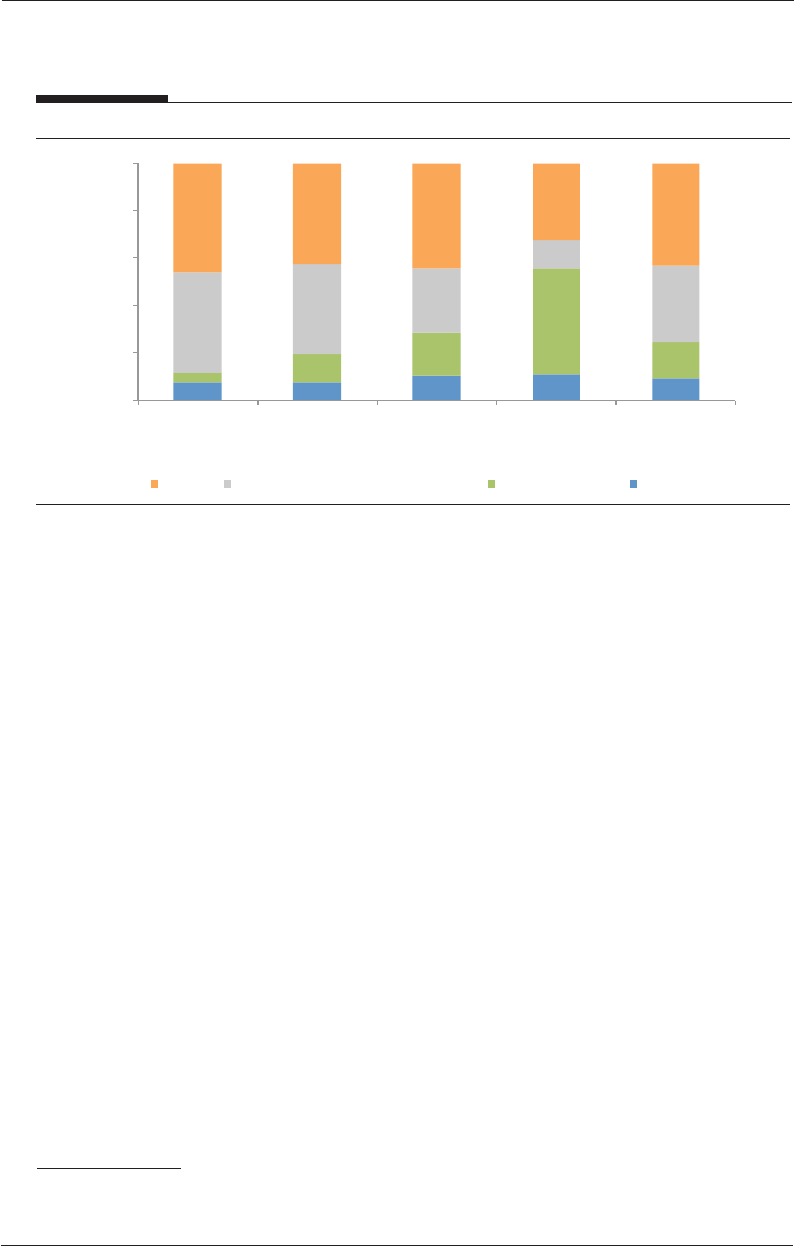
258
Lambie-Hanson, Herbert, Lew, and Sanchez-Moyano
Refereed Papers
Exhibit 10
Large Investors’ Use of Financing by Property Purchase Price
8
7
10
11
9
4
12
18
44
16
42
38
27
12
32
46
42
45
32
43
0
20
40
60
80
100
Under $75,000 $75,000 to
$124,999
$125,000 to
$249,999
$250,000+ Total
Percent of purchases
Purchase price
Cash Investor-affiliated hard-money lender Small local bank Other lender
Notes: Includes purchases by large investors. Percentages may not add to 100 because of rounding.
Source: Authors’ calculations of data from the Warren Group
Many investors in Boston turn to each other for hard-money loans. Basing our analysis on an in
depth review of the purchase mortgages in our dataset, we find that seven investors operated their
own hard-money lending firms that finance acquisitions for themselves and other investors.
15
One
investor noted that it became common practice in 2008 and 2009, at the peak of the crisis, for
investors to lend to each other because banks were restricting the flow of credit, and investors were
forced to find another source of money. As shown in exhibit 10, hard-money lending was most
common for lower cost properties, particularly those priced at less than $125,000. Only 12 percent
of acquisitions of high-cost properties (priced at more than $250,000) involved hard-money loans
from affiliated investors.
The third most common type of financing in our sample of purchases by large investors, making
up 16 percent of transactions, was loans by small community banks and thrift banks. These
transactions dwarfed the five loans in our sample made by large commercial banks that operate
nationally. The large investors we interviewed reported having established relationships with small
community banks that enabled them to secure a purchase-money mortgage or refinance after re-
habilitating and renting out a property, with one investor noting that “[community] banks tend to
have the best prices and are actively lending. Larger commercial banks have no interest in lending
to investors and they don’t have the local knowledge of the housing market that community banks
do.” As the same investor explained, it is in the interest of a foreclosed property investor to obtain
a bank loan because of the low interest rates; “even for guys who have a lot of their own equity,
I don’t know a single person who doesn’t take a loan [from a traditional lender]. Borrowing is so
cheap that I can still make money and achieve a 10 percent cap rate. I make 5 percent on every
15
We classified lenders based on information we gained from their websites and other online sources about product
offerings, length of loan terms, and underwriting practices.

Foreclosed Property Investors in a Strong Housing Market City:
A Case Study of Boston
259Cityscape
nickel I borrow, so leverage is working in my favor.” Community banks appeared to be particularly
active in financing the purchase of higher cost properties. Loans from community banks financed
the purchase of 44 percent of the properties bought by large investors for more than $250,000.
The type of financing used at purchase does not tell the whole story, though. Through our inter-
views, we identified a common two-step financing model: taking out a short-term, high-cost loan
or using their own equity to finance the initial purchase and rehabilitation of a property, and then
after the property is rented and producing a stable income stream, refinancing through a traditional
lender. We confirmed this behavior in our dataset. After using a mortgage from a hard-money
lender to purchase a foreclosed property, 56 percent of investors took out a subsequent mortgage
on the same property, presumably a refinance loan, at a later date.
16
In contrast, 39 percent of
buyers purchasing with cash later took out a mortgage, and 42 percent of those initially using
loans from small local banks appeared to refinance. Only 29 percent of investors using other types
of financing were observed to take out another mortgage after the purchase date. These investors
initially borrowed from large banks, mortgage companies, and hard-money lenders not affiliated
with known Suffolk County foreclosed property investors.
One investor explained that his strategy of initially using hard-money loans and later refinancing
through a bank proved effective because banks were more likely to assist with financing a fore-
closed property if they saw that the property had been rehabilitated and leased for a certain period
of time with positive cash flow. In his words, “once you fix it up and rent it out, the property is
worth more than what you bought it, in the bank’s eyes, because it’s generating income. The bank
will run the cap rate and see that after the rehab, the property is now worth $450,000 instead
of $250,000, bringing in $3,000 per month in positive cash flow. Then the bank will allow you
to refinance 75 percent of the value.” Another investor added that his ability to refinance with a
traditional lender after purchasing a foreclosed property affected his decision to resell or hold the
property; if he was able to secure refinancing, he would certainly continue to hold it.
From our interviews we learned that owner-occupants and small-scale investor landlords struggled
to compete with large investors in Boston because large investors had greater access to cash, hard-
money loans, and alternative lending streams. Financing was a particularly salient issue for those
wanting to buy properties that would require substantial spending on rehabilitation. One nonprofit
organization staff member who worked with small property owners observed that “the big issue is
that usually you can’t get more money in your loan for making improvements.” According to the
same person, although small property owners previously had the ability to take out a bank loan
for improvements, limited credit availability for this purpose had made it more difficult to borrow
for rehabilitation expenses. Another nonprofit organization staff member observed that “small
investor-owners tend to operate from check to check to make repairs.” He had seen cases of small
investor-owners who were foreclosed on because they wound up overpaying for a property in poor
condition, initially intending to accumulate rental income but ultimately finding themselves unable
to keep up with the necessary repairs and maintenance.
16
Our data do not enable us to distinguish between refinance mortgages and subordinate-lien mortgages taken out after the
time of purchase.

260
Lambie-Hanson, Herbert, Lew, and Sanchez-Moyano
Refereed Papers
Postpurchase Property Management
As we have established, investors accounted for a large share of foreclosed property acquisitions in
Suffolk County. We now turn to the question of what these investors did with the properties they
bought. We find that investors in Boston and neighboring communities tended to hold proper-
ties, although some resold or even flipped them. Holding properties in Boston appears to have
been desirable because of the strong rental market in the area, especially renting units to voucher
holders. Positive expectations about rents and future house prices led some investors to spend
substantial sums rehabilitating properties.
Strategies With Respect to Holding or Selling Properties and the Challenges of
Rental Management
Mallach (2010a) presents a typology of distressed property investors that distinguishes between
several common types of business strategies. His typology includes four categories: rehabbers,
flippers, milkers, and holders. Although rehabbers and flippers purchase distressed properties
with the goal of reselling them to buyers, the main difference between the two categories is that
rehabbers are more focused on investing in necessary capital improvements and renovations for the
property, while flippers typically put minimal investment into the property before selling quickly
to other buyers. Meanwhile, milkers and holders purchase properties with the intention of renting
them out. Unlike holders, however, milkers do not invest in property maintenance and tenant
selection practices because they are focused on the cash flow that can be generated from the spread
between rents and the low property acquisition and maintenance costs. Holders are generally more
cognizant of property appreciation and dedicate more financial resources to property maintenance
and tenant screening.
In practice, almost all of the large foreclosed property investors in Boston had both held and resold
properties, rather than pursuing a single strategy. The predominant strategy was to hold, however,
at least until the housing market improved. Overall, 68 percent of properties were held for at least
2 years, and 53 percent were still owned by the same large investor as of January 2015. Looking at
the 33 large investors individually, 21 (64 percent) held at least two-thirds of their properties for
2 years or longer. Of these 21 investors, 12 still held two-thirds of their properties by January 2015.
Despite the prevalence of a holding strategy among investors, 8 large investors resold at least one-
half of their properties within 2 years of purchase. These investors could be classified as flippers
or rehabbers, according to Mallach’s typology. For the most part, though, flipping in Boston seems
to have been rare; for the properties resold, the median time to resale was about 9 months, which
suggests that at least some improvements could be made to the properties before they were resold.
Only one large investor had a median holding time of less than 30 days, while another two had
median times until resale of less than 90 days. Only 117 properties resold by large investors (7 per-
cent) were resold in less than 90 days.
Based solely on purchase and resale prices (ignoring other factors, like costs of building improve-
ments or financing), 97 percent of resold properties by large investors resulted in gross gains (that is,
sales price exceeding purchase price). The median dollar gain was $96,000; the median percentage

Foreclosed Property Investors in a Strong Housing Market City:
A Case Study of Boston
261Cityscape
gain was 63 percent. As a point of comparison, the median gross return on a nonforeclosed
property purchased and sold in Suffolk County during this period was 12 percent.
17
Foreclosed
property investors earned these high returns despite the fact that most of their portfolios were
concentrated in low-income areas with high foreclosure rates.
Most sales by large investors conducted through 2012 were to owner-occupants, with only 39
percent of properties sold to other investors. The prevalence of sales to owner-occupants or other
parties varied greatly, however, based on the investor’s primary business strategy. Most of the
investors who had resold the bulk of their properties primarily targeted owner-occupants, and even
when they sold to other investors, they typically did not sell to another large investor. On the other
hand, among investors who primarily held their properties, it was less common to sell to owner-
occupants; they instead generally sold to other investors, often to large investors.
18
The dominant strategy of holding properties in Suffolk County appears to have been driven by
high rental demand, although house price recovery served as an incentive to resell. One investor
explained that he preferred to resell multifamily properties after acquiring and renovating them,
rather than holding properties for rental income. “Multifamily market values are such that it
makes sense to flip the properties,” he said. “We usually extensively renovate our properties so the
condition they are in when we purchase them is irrelevant. They will sell for a premium given our
renovations.” To estimate the feasibility of a resale versus a holding strategy for each individual
small multifamily property, he would determine whether he and his partner were able to achieve a
per-property profit of $50,000. If not, he would hold onto these properties for the rental income;
he estimated that he wound up holding around 25 percent of the inventory that he purchased at
auction. Over time, Boston and other cities may see a larger share of investors reselling their prop-
erties. Two investors commented that they and their partners initially held and rented out nearly all
their purchases, but as sales prices were increasing in the area, they planned to divest.
Similar to Immergluck and Law’s (2014) findings on Atlanta, we learned that many investors in
Boston who rented out their properties had a preference for tenants with Housing Choice Vouch-
ers. Voucher holders were attractive as tenants because they represented a reliable stream of rental
income in neighborhoods where lower income households may be stretched to afford market-rate
rents. As one investor put it, voucher tenants represented “guaranteed money,” as the federal
government pays the difference between the tenant contribution and the fair-market rent. Voucher
holders were also more likely to seek housing in distressed neighborhoods because of the lack of
affordable housing throughout Boston. Several investors noted that within these neighborhoods,
fierce competition among landlords over leasing to voucher holders provided incentives for inves-
tors to rehabilitate distressed properties and to use more expensive finishes, because nicer units
tend to rent out faster.
Not all investors were competing for voucher tenants, however. Interview participants noted that
very few “mom and pop” investors were adept at handling vouchers, because of strict requirements
and high housing standards mandated by the program. Larger, “professional” landlords had more
17
As an anonymous referee pointed out, investors who are renting out their properties may delay sales until they receive a higher
asking price. By contrast, traditional sellers may feel a greater urgency to sell, which could lead them to accept lower offers.
18
For a more detailed description of these patterns, see Herbert et al. (2013).

262
Lambie-Hanson, Herbert, Lew, and Sanchez-Moyano
Refereed Papers
capacity to manage the requirements for the voucher program, particularly those with property
management companies. The volatility of the market and recent policy changes also presented
broader challenges in rental and property management, particularly for less sophisticated, smaller
investors. For example, increased legal protections provided to tenants living in foreclosed homes
have affected purchase and property management strategies. In 2010, Massachusetts enacted a law
that prohibited banks from evicting tenants living in foreclosed properties.
19
Managing rents and
existing tenants in previously foreclosed buildings that are still occupied can present challenges
for landlords and can deter investors from purchasing these properties. One investor noted that,
although he had purchased several occupied buildings, they were “special cases” in which he got a
“really good deal.” Another investor noted that, in some cases, he was able to negotiate a “cash for
keys” deal with existing tenants in foreclosed properties, requiring them to leave within 30 days if
he gave them $2,500.
Property Improvements
We unfortunately lack reliable building permit or housing condition data for most of the proper-
ties in our sample, so we must rely on anecdotal information from our interviews about the
extent to which investors made property improvements. In these interviews, we were told that
private investors were more likely than nonprofit organizations to target less physically distressed
foreclosed properties. One nonprofit organization staff member noted that his organization tended
to be outbid by investors for properties that required lower levels of rehabilitation. Meanwhile, the
“seriously deteriorated and abandoned” properties that comprised one-half of his organization’s
portfolio received little competition from private investors. The same person explained that his
organization mostly targeted highly distressed foreclosed properties, however, because “they were
the cancers on the street. Properties that are feasible on a market basis [are attractive to a] different
set of investors.” Recall that as we discussed in the section Where and What Investors Purchase,
one-half of the properties that large investors acquired were condominium units, which may have
required less rehabilitation than small multifamily and single-family properties.
As the same nonprofit organization staffer explained, unlike a mission-based nonprofit organiza-
tion, an investor acquiring foreclosed properties without subsidy would not necessarily ensure that
properties were energy efficient and that all systems had been “brought up to date, making them
durable and sustainable” to potential owner-occupants. The cost of these upgrades might not be
fully recaptured in the sales price of the property, particularly in lower income neighborhoods. The
availability of subsidies through federal programs such as the NSP enabled nonprofit organizations
to upgrade properties to a greater extent than the purchasing power of these lower income house-
holds alone could support.
The level of rehabilitation required by foreclosed properties can deter owner-occupants and small
investor landlords from purchasing them. Compared with properties with similar physical or
19
The law is considered one of the most comprehensive in the United States for protecting residents of foreclosed
properties. It includes a “just cause” section that bars banks from evicting tenants from foreclosed properties unless
the tenant fails to pay rent, damages the property, or otherwise gives “just cause” for eviction. It also imposes a longer
preforeclosure period on banks that do not make a concerted effort to restructure loans with homeowners, criminalizes
mortgage fraud, and provides property tax exemptions for charitable organizations that purchase foreclosed properties
(Commonwealth of Massachusetts, 2010).

Foreclosed Property Investors in a Strong Housing Market City:
A Case Study of Boston
263Cityscape
locational characteristics in the traditional housing market, REO properties are typically in worse
condition (Mallach, 2010b). A real estate agent who had also invested in foreclosed properties
told us that the REO properties he saw would often have “leaking on multiple floors and [be in]
total disrepair.” In fact, Mallach (2007) documented that it was not uncommon for the combined
costs of property acquisition and a comprehensive, code-compliant rehabilitation of a severely
deteriorating property in a distressed neighborhood to easily surpass both the market value of the
renovated property and the cash flow generated from the rental income.
Information provided by investor respondents indicated that a number of investors were spending
a significant amount on rehabilitation, particularly of small multifamily properties. One investor
who bought two- and three-family houses noted that although he is “prepared to spend up to
$100,000 on some properties,” he would spend “as little as $25,000 or less on others,” and
another investor estimated that he spent a minimum of $50,000 to $60,000 per property on
rehabilitation, but that rehabilitation costs can be higher. For example, he estimated that he would
spend $80,000 to $100,000 on a property he was planning to resell to other investors. For projects
supported by NSP funds, investors reported undertaking a greater amount of renovation. An inves-
tor who participated in NSP projects estimated that he spent between $100,000 and $125,000
per property on rehabilitation, with most of the properties requiring gut rehabilitations. Another
investor respondent who was involved in the NSP cited similar figures, spending about $100,000
on rehabilitation per unit using NSP subsidy money. If not using NSP subsidy money, the same
investor reported spending about $50,000 to $75,000 on rehabilitating a market-rate property.
What is not clear is whether these properties renovated with NSP funds were in substantially worse
condition to begin with, or if the subsidy actually provided incentives to bring properties to higher
standards than the market would achieve on its own.
Interview participants had heterogeneous opinions on whether investors, by and large, performed
a sufficient level of maintenance and improvements to their properties. Multiple interview partici-
pants, however, including nonprofit organization workers, government staff, and investors, argued
that REO properties (that is, those owned by banks) tended to be in worse condition than investor-
owned properties, largely because of the fact that banks were using nonlocal property management
companies to oversee their portfolios. So, investors, though perhaps not perfect actors, seemed to
be a lesser evil in the eyes of some of the government and nonprofit organization staff members we
interviewed.
One person who oversees property inspection services for a Boston-based nonprofit organiza-
tion, managing several REO properties in its portfolio, noted that although a property might
be acceptable at the time of the foreclosure auction, conditions could deteriorate the longer the
home remained under bank ownership, with structural, plumbing, and heating issues cropping
up. Trustees holding foreclosed properties may be reluctant to make necessary repairs, let alone
improvements. La Jeunesse (2013) found in her national study that around 65 percent of REO
properties were sold with no work or minimal work done, increasing the need for repairs and
improvements after sale, and Lambie-Hanson (2013) found that bank-owned properties in Boston
were the subject of many constituent complaints to city government about property conditions.

264
Lambie-Hanson, Herbert, Lew, and Sanchez-Moyano
Refereed Papers
Summary and Conclusions
Investors have played a significant role in acquiring foreclosed properties in Boston and nearby
communities, with large investors having been particularly active in neighborhoods with lower
incomes and higher proportions of minority residents. With a higher percentage of these purchases
paid for using cash or hard-money loans, investors channeled a substantial amount of capital into
these neighborhoods through nontraditional channels. In that way, investor activity has appeared
to play a stabilizing influence in helping absorb the high volume of distressed properties that have
come on the market.
All told, investors purchased 44 percent of foreclosed properties sold at foreclosure auction or out
of REO from 2007 through 2012. Of these properties, one-half were purchased by 33 large inves-
tors who acquired 10 or more properties. Among the properties that large investors purchased, 41
percent were small multifamily dwellings, which, in many cases, required substantial investment.
In addition, 51 percent of the properties purchased were condominiums, which were typically
located in small multifamily buildings, many of which had been converted in recent years. Because
of the recent conversions, these units may not have required substantial investment. Also, the cost
of exterior renovations, if made, would be shared across units.
Although investors played a large role in purchasing distressed properties, it is not clear how
the market would have absorbed these properties in their absence. Nonprofit organization and
government staff using NSP funds to purchase properties reported that they and prospective owner-
occupants experienced competition from investors to purchase small multifamily properties, particularly
those properties that needed less improvement. Investors and prospective owner-occupants also
competed to purchase condominium properties, because the properties were smaller (one unit
instead of several), had lower price points (making them attractive to owner-occupants), and ap-
peared to require less substantial renovation. The investors we interviewed reported experiencing
competition not only from mission-driven organizations and owner-occupants but, increasingly,
over time, from other investors. We explained how large investors often purchased properties at
foreclosure auction, giving them “first pick” of the foreclosed properties. We also discussed how
their market knowledge and connections with real estate agents helped them identify REO proper-
ties quickly and seize opportunities. Most important to our discussion, however, large investors
had access to a variety of financing sources, which made them more agile in the market. During a
period in which traditional mortgage credit became scarce (see, for example, Goodman, Zhu, and
George, 2014), this advantage was likely to be important not only in strong housing market cities
like Boston but also in weaker market areas.
One concern about a high level of investor activity is whether investors have displaced potential
owner-occupants who otherwise would have acquired these properties. Our investigation did find
that most of the properties acquired by investors were held as rental units. This outcome, however,
appears to mostly reflect the greater financial returns available from renting versus selling and,
therefore, the somewhat limited demand from owner-occupants. At the same time, based on a
subsample of large investors, a small majority of the properties that investors resold were bought
by owner-occupants, so investors were, to some extent, serving as a conduit for returning these
properties to the owner-occupied stock.

Foreclosed Property Investors in a Strong Housing Market City:
A Case Study of Boston
265Cityscape
The homeownership rate in lower income and minority neighborhoods in Suffolk County has been
40 percent or less, and so there has always been a sizeable fraction of rented housing in these areas.
To the extent that investors bought and rented out properties previously held by owner-occupants,
they have further increased the rental stock and may have had a positive effect on rental afford-
ability. That said, one nonprofit organization staff member we interviewed told us that foreclosed
property investors commonly raised rents on existing tenants in the low-income neighborhood
where she worked, even in cases in which property renovations were not made.
Another key issue is whether these investors have performed a sufficient degree of maintenance
and improvements to reduce the potential that these formerly distressed properties act as blights
on their neighborhoods. Although it was difficult to measure the extent of property improvements
from the information available, the interviews we conducted for this study indicated that it was
common for investors to pursue at least modest improvements after acquiring these properties to
better position them for rent or sale. Problematic activities such as predatory flipping and milking
of properties did not appear common in this market. The nonprofit organization and government
staff members we interviewed confirmed that Suffolk County has largely been spared these prob-
lems.
We note that Mallach (2014) had a similar finding for Las Vegas, although as Herbert, Lew, and
Sanchez-Moyano (2013) discussed in their comparative analysis, foreclosed property flipping in
Las Vegas was more common at the beginning of the crisis. Immergluck and Law (2014) found
considerably more flipping and milking in Atlanta. They argued that milkers may simply have
been owners who had not been able to sell and who abandoned their properties rather than
maintained them. Ford et al. (2013) reported that flipping and milking in Cleveland was common,
with milking particularly prevalent among out-of-state investors who had misjudged the scale of
deterioration of the REO properties they were buying and were unwilling or unable to resell these
properties.
In the Boston area, optimism about rents and home prices seems to have been better founded,
which may have spared the area problems of milking and abandonment—although, as we learned
from the investors we interviewed, even those in Boston sometimes purchased properties without
clear intentions of whether to hold or resell, waiting to decide on their strategies until they deter-
mined if, and under what conditions, they could refinance. This is another example of how market
factors influence investors’ profits and business strategies.
The typical improvements the Boston-area investors made to properties may not have been as
extensive as those pursued with the support of public subsidies, but the area’s relatively high hous-
ing values and significant rental demand provided an incentive for investors to maintain properties
in at least decent condition, in contrast with investors’ maintenance efforts in cities like Cleveland.
Given the importance of this issue, an area for further research is to undertake a more systematic
assessment of the types of properties investors target and whether they are more or less likely
to make investments in property improvements. We expect that the results for strong housing
market cities like Boston will differ from weaker market areas, where investors stand to gain less in
expected rents and resale values and are less likely to be locally based, making it more difficult for
them to oversee rehabilitation projects.

266
Lambie-Hanson, Herbert, Lew, and Sanchez-Moyano
Refereed Papers
While we caution that the results presented in this case study are confined to the Boston area, we
think our findings are likely to be applicable to other cities with relatively strong housing markets.
In these cities, investors have stronger incentives to maintain and rehabilitate properties, which
may result in fewer burdens on municipalities’ code enforcement units. Likewise, the need for
mission-driven organizations to acquire distressed properties to stabilize markets may not be as
pressing, aside from pursuing broader objectives, such as providing affordable housing, performing
greater degrees of property rehabilitation, and engaging in historic preservation.
Acknowledgments
The authors thank Frank Ford, Dan Immergluck, and Alan Mallach for their help in thinking
through some of the key research questions and research design. They also thank Erin Graves,
Solomon Greene, Danilo Pelletiere, five anonymous referees, and the editor for their helpful
comments and suggestions. The authors are also grateful to the interview participants who shared
their experiences and insights. The research contained herein was conducted for the What Works
Collaborative, composed of researchers from the Brookings Institution’s Metropolitan Policy
Program, the Joint Center for Housing Studies of Harvard University, the New York University
Furman Center for Real Estate and Urban Policy, and the Urban Institute’s Metropolitan Housing
and Communities Policy Center (the Research Collaborative). The Research Collaborative received
support from the Annie E. Casey Foundation, the Ford Foundation, the John D. and Catherine T.
MacArthur Foundation, the Kresge Foundation, the Open Society Foundations, and the Surdna
Foundation. The Federal Reserve Bank of Boston made possible our access to the Warren Group
data. The findings in this report are those of the authors alone and do not necessarily reflect the
opinions of the What Works Collaborative, supporting foundations, the Federal Reserve Bank of
Philadelphia, or the Federal Reserve System.
Authors
Lauren Lambie-Hanson is a senior specialist in the Risk Assessment, Data Analysis and Research
Group of the Supervision, Regulation and Credit Department at the Federal Reserve Bank of
Philadelphia.
Christopher E. Herbert is the Managing Director of the Joint Center for Housing Studies of Harvard
University.
Irene Lew is a research assistant at the Joint Center for Housing Studies of Harvard University.
Rocio Sanchez-Moyano is a research analyst at the Joint Center for Housing Studies of Harvard
University.

Foreclosed Property Investors in a Strong Housing Market City:
A Case Study of Boston
267Cityscape
References
City of Boston. 2005. Real Estate Trends Report for FY 2004 and FY 2005. Boston: City of Boston,
Department of Neighborhood Development. https://www.cityofboston.gov/Images_Documents/
2005_Mid-Year_Real_Estate_Trends_tcm3-8069.pdf.
———. 2000. Condominium Trends: A Close Up Report—July 2000. Boston: City of Boston,
Department of Neighborhood Development. https://www.cityofboston.gov/Images_Documents/
CondoConversionWeb_tcm3-7736.pdf.
Commonwealth of Massachusetts. 2010. Summary of an Act Relative to Mortgage Foreclosures
(Chapter 258 of the Acts of 2010). Boston: Commonwealth of Massachusetts. http://www.mass.gov/
ocabr/consumer-rights-and-resources/housing/foreclosure-resources/info-about-foreclosure-laws-
and-regs/summary-of-an-act-relative-to-mortgage.html.
Ellen, Ingrid Gould, Josiah Madar, and Mary Weselcouch. 2014. “The Foreclosure Crisis and
Community Development: Exploring REO Dynamics in Hard-Hit Neighborhoods,” Housing Studies.
Online only. DOI: 10.1080/02673037.2014.882496.
Fisher, Lynn M., and Lauren Lambie-Hanson. 2012. “Are Investors the Bad Guys? Tenure and
Neighborhood Stability in Chelsea, Massachusetts,” Real Estate Economics 40 (2): 351–386.
Ford, Frank, April Hirsh, Kathryn Clover, Jeffrey A. Marks, Robin Dubin, Michael Schramm, Tsui
Chan, Nina Lalich, Andrew Loucky, and Natalia Cabrera. 2013. The Role of Investors in the One-to-
Three Family REO Market: The Case of Cleveland. Cambridge, MA: Joint Center for Housing Studies
of Harvard University. http://www.jchs.harvard.edu/sites/jchs.harvard.edu/files/w13-12_
cleveland_0.pdf.
Garboden, Philip M.E., and Sandra Newman. 2012. “Is Preserving Small, Low-End Rental Housing
Feasible?” Housing Policy Debate 22 (4): 507–526.
Gerardi, Kris, Lauren Lambie-Hanson, and Paul S. Willen. 2013. “Do Borrower Rights Improve
Borrower Outcomes? Evidence From the Foreclosure Process,” Journal of Urban Economics 73 (1):
1–17.
Goodman, Laurie S., Jun Zhu, and Taz George. 2014. “Where Have All the Loans Gone? The
Impact of Credit Availability on Mortgage Volume,” Journal of Structured Finance 20 (2): 45–53.
Herbert, Christopher, Lauren Lambie-Hanson, Irene Lew, and Rocio Sanchez-Moyano. 2013.
The Role of Investors in Acquiring Foreclosed Properties in Boston. Cambridge, MA: Joint Center for
Housing Studies of Harvard University. http://www.jchs.harvard.edu/sites/jchs.harvard.edu/files/
w13-6_herbert_lambie_lew_moyano.pdf.
Herbert, Christopher, Irene Lew, and Rocio Sanchez-Moyano. 2013. The Role of Investors in Acquir-
ing Foreclosed Properties in Low- and Moderate- Income Neighborhoods: A Review of Findings From Four
Case Studies. Cambridge, MA: Joint Center for Housing Studies of Harvard University. http://www.
jchs.harvard.edu/sites/jchs.harvard.edu/files/w13-11_herbert_lew_moyano.pdf.

268
Lambie-Hanson, Herbert, Lew, and Sanchez-Moyano
Refereed Papers
Immergluck, Dan, and Jonathan Law. 2014. “Investing in Crisis: The Methods, Strategies, and Ex-
pectations of Investors in Single-Family Foreclosed Homes in Distressed Neighborhoods,” Housing
Policy Debate 24 (3): 568–593.
King, Steve. 2012. Who Owns Your Neighborhood? The Role of Investors in Post-Foreclosure Oakland.
Oakland, CA: Urban Strategies Council. http://www.neighborhoodindicators.org/sites/default/files/
publications/whoownsyourneighborhood_report.pdf.
La Jeunesse, Elizabeth. 2013. Home Improvement Spending on Distressed Properties: 2011 Estimates.
Cambridge, MA: Joint Center for Housing Studies of Harvard University. http://www.jchs.harvard.
edu/sites/jchs.harvard.edu/files/n13-1_lajeunesse.pdf.
Lambie-Hanson, Lauren. 2013. “When Does Delinquency Result in Neglect? Mortgage Distress and
Property Maintenance.” Public Policy Discussion Paper No. 13-1. Boston: Federal Reserve Bank of
Boston. http://www.bostonfed.org/economic/ppdp/2013/ppdp1301.pdf.
Mallach, Alan. 2014. “Investors and Housing Markets in Las Vegas: A Case Study,” Housing Policy
Debate 24 (4): 769–801.
———. 2010a. Meeting the Challenge of Distressed Property Investors in America’s Neighborhoods. New
York: Local Initiatives Support Corporation.
———. 2010b. “REO Properties, Housing Markets, and the Shadow Inventory.” In REO & Vacant
Properties: Strategies for Neighborhood Revitalization, edited by Prabal Chakrabarti, Matthew Lam-
bert, and Mary Helen Petrus. Boston: Federal Reserve Bank of Boston; Cleveland: Federal Reserve
Bank of Cleveland; Washington, DC: Federal Reserve Board: 13–22.
———. 2007. Landlords at the Margins: Exploring the Dynamics of the One- to Four-Unit Rental Hous-
ing Industry. Cambridge, MA: Joint Center for Housing Studies of Harvard University. http://www.
jchs.harvard.edu/sites/jchs.harvard.edu/files/rr07-15_mallach.pdf.
McKim, Jenifer B. 2011. “Real Estate Becoming a Cash Economy,” Boston Globe, October 2. http://
www.boston.com/realestate/news/articles/2011/10/02/real_estate_becoming_a_cash_economy/.
———. 2008. “Amid the Despair of Foreclosures, Many See a Golden Opportunity,” Boston Globe,
December 23. http://www.boston.com/business/articles/2008/12/23/amid_the_despair_of_
foreclosures_many_see_a_golden_opportunity/.
Newburger, Harriet. 2010. “Acquiring Privately Held REO Properties With Public Funds: The Case
of the Neighborhood Stabilization Program.” In REO and Vacant Properties: Strategies for Neighbor-
hood Stabilization, edited by Prabal Chakrabarti, Matthew Lambert, and Mary Helen Petrus. Boston:
Federal Reserve Bank of Boston; Cleveland: Federal Reserve Bank of Cleveland; Washington, DC:
Federal Reserve Board: 101–106.
Treuhaft, Sarah, Kalima Rose, and Karen Black. 2011. “When Investors Buy Up the Neighborhood:
Preventing Investor Ownership From Causing Neighborhood Decline,” Community Investments 23
(1): 19–33.
